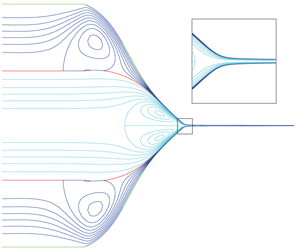Article contents
A numerical simulation of coaxial electrosprays
Published online by Cambridge University Press: 20 December 2019
Abstract

A complete electrohydrodynamic axisymmetric model of coaxial electrosprays under constant electrical permittivities and conductivities, and strict immiscibility of the liquids, is presented. The numerical solution of the model is experimentally validated, and a detailed portrait of the complex physics begotten by the large spectrum of variables involved is described in a choice of representative cases. The appearance of surface charge in both the outer and the inner free interfaces, and some of their interesting features, are revealed. Among those, the possibility of the appearance of a limited segment of opposite charge (negative, if the polarity of the applied potential is positive, or vice versa) in the inner free surface at the transition region illustrates the unexpected features exhibited by this complex system. This has fundamental physicochemical implications in the production of core–shell formulations or the use of the system in analytical chemistry, among a wide variety of applications.
JFM classification
- Type
- JFM Papers
- Information
- Copyright
- © 2019 Cambridge University Press
References
- 11
- Cited by




